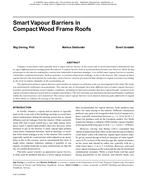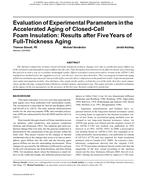-
-
Available Formats
- Options
- Availability
- Priced From ( in USD )
-
Available Formats
-
- Immediate download
-
$16.00Members pay $7.00
- Add to Cart
Customers Who Bought This Also Bought
-

Wooden Stud Walls with Aerogel Thermal Insulation-Materia...
Priced From $16.00 -

Can VIP be an Alternative Solution for Energy Retrofit fo...
Priced From $16.00 -

Smart Vapour Barriers in Compact Wood Frame Roofs
Priced From $16.00 -

Evaluation of Experimental Parameters in the Accelerated ...
Priced From $16.00
About This Item
Full Description
Energy end uses and interior comfort conditions were monitored in 11 deep energy retrofits (DERs) in a mild marine climate. Two broad categories of DER envelope were identified: first, bringing homes up to current code levels of insulation and airtightness, and second, enhanced retrofits that go beyond these code requirements. The efficacy of envelope measures in DERs was difficult to determine, due to the intermingled effects of enclosure improvements, HVAC system upgrades, and changes in interior comfort conditions. While energy reductions in these project homes could not be assigned to specific improvements, the combined effects of changes in enclosure, HVAC system, and comfort led to average heating energy reductions of 76% (12,937 kWh) in the five DERs with pre-retrofit data, or 80% (5.9 kWh/ft2) when normalized by floor area. Overall, net site energy reductions averaged 58% (15,966 kWh; n=5), and DERs with code-style envelopes achieved average net site energy reductions of 65% (18,923 kWh; n=4). In some homes, the heating energy reductions were actually larger than the whole-house reductions that were achieved, which suggests that substantial additional energy uses were added to the home during the retrofit that offset some heating savings. Heating system operation and energy use was shown to vary inconsistently with outdoor conditions, suggesting that most DERs were not thermostatically controlled and that occupants were engaged in managing the indoor environmental conditions.
Indoor temperatures maintained in these DERs were highly variable, and no project home consistently provided conditions within the ASHRAE Standard 55-2010 heating season comfort zone. Thermal comfort and heating system operation had large impacts on performance and were found to depend upon the occupant activities, so DERs should be designed with the occupants' needs and patterns of consumption in mind. Beyond-code building envelopes were not found to be strictly necessary for the achievement of deep energy savings in existing uninsulated homes in mild marine climates, provided that other energy end uses were comprehensively reduced.We recommend that mild-climate DERs pursue envelopes in compliance with the 2012 International Energy Conservation Code (IECC) and pair these with high-efficiency, off-the-shelf HVAC equipment. Enhanced building envelopes should be considered in cases where very low heating energy use (less than 1,000 kWh/year or less than 0.5 kWh/ft2 x year) and enhanced thermal comfort (ASHRAE Standard 55-2010) are required, as well as in those situations where substantial energy uses are added to the home, such as decorative lighting, cooling, or smart-home audio/visual and communication equipment.
Presented at Thermal Performance of Exterior Envelopes of Whole Buildings XII, December 2013





